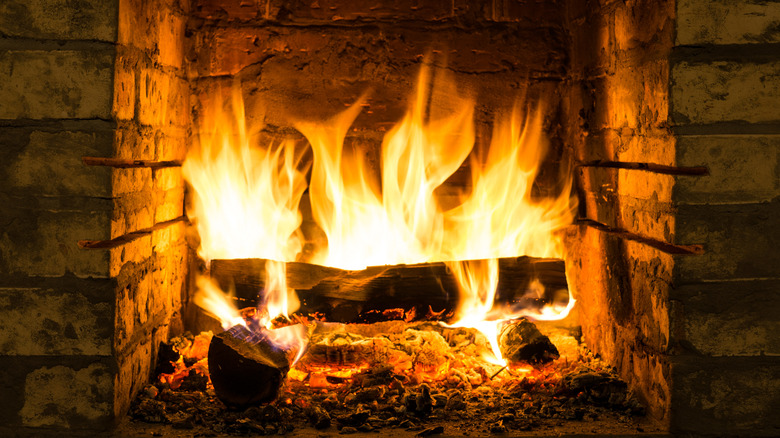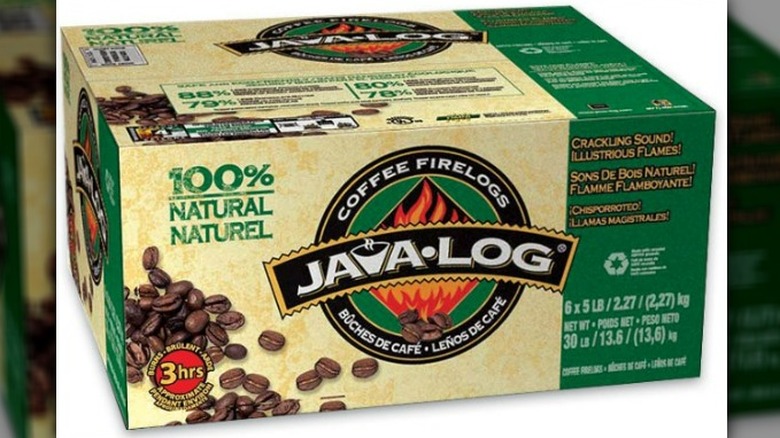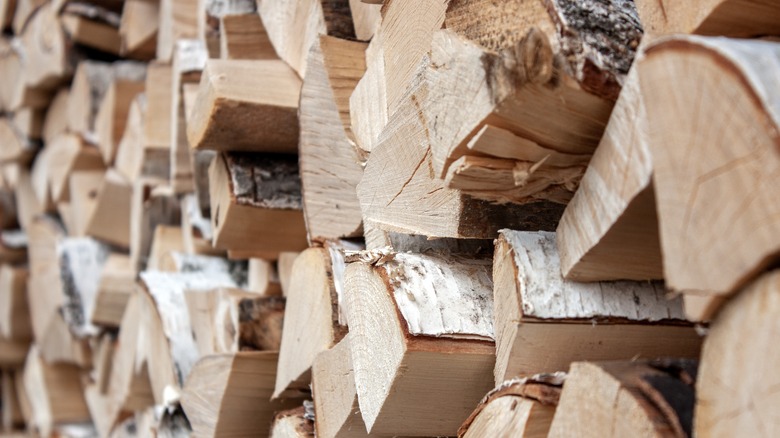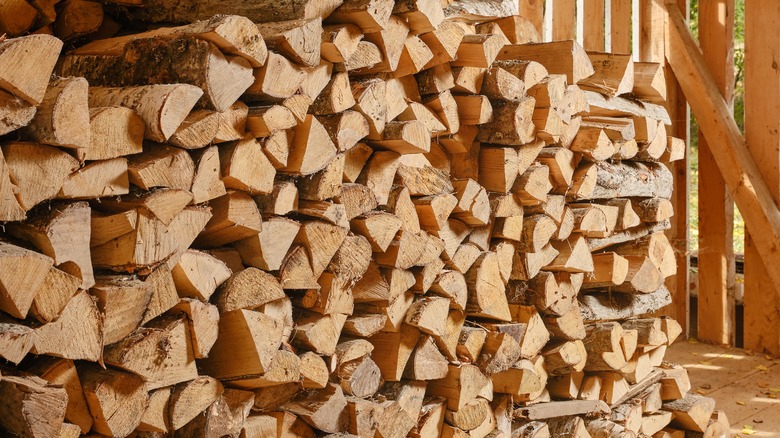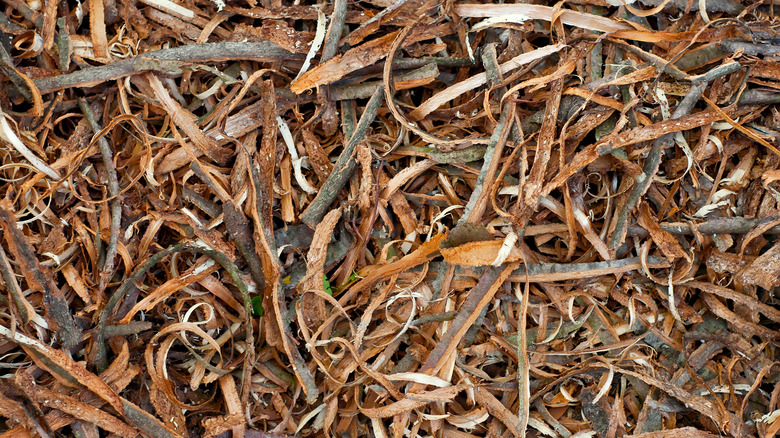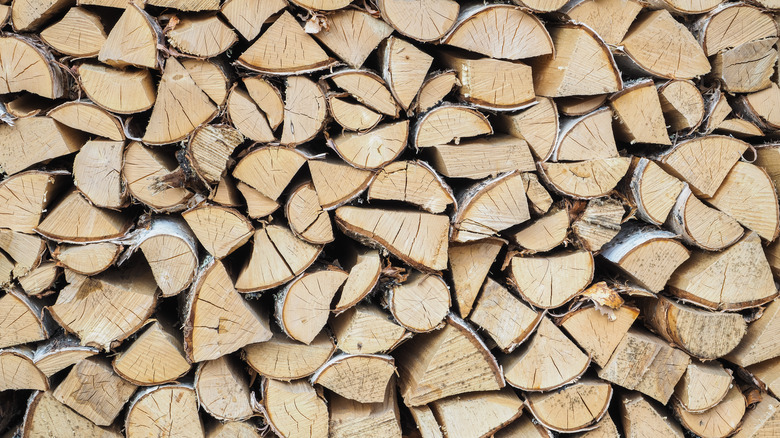Sustainable Fuel Options For Your Wood Burning Fireplace
Nothing is more comforting than snuggling up in front of a fireplace on a cold winter's night. What's not so comforting is knowing that wood burning isn't as eco-friendly as we were once led to believe. Have you ever heard of the phrase, "where there's smoke, there's fire"? Well, wood smoke actually contains carbon monoxide and nitrogen oxides, which the American Lung Association states plays a major role in creating particle pollution. Both carbon dioxide and methane are also byproducts of wood smoke, which, as you might know, are two of the three biggest offenders in the fight to reverse climate change, per UN News.
While it's a good idea to refrain from burning anything nowadays, we also know that fireplaces are built for a reason and that just because you're trying to be more eco-aware doesn't mean the cold weather is going to cease to exist. That's why we've pulled together some more suitable fireplace fuels that have less of an impact on our Spaceship Earth. These fuels can come from a variety of sources, including plant-based or reclaimed woods and certain types of organic matter. They're also more cost-effective in the long run. Remember that nothing says the holidays like a fireplace. They're, after all, meant to contain the warm glow of the holiday spirit.
Eco logs
Eco logs are considered a sustainable option because they're made from recycled materials. They're typically made with wood-related byproduct (like sawdust, wood chips, coconut husks, and even coffee, per Pine Mountain), that has been pressed into a log-shaped form and coated with an eco-friendly wax or resin so that they can catch (and stay) on fire. When compared to standard timber, eco logs light quicker, keep a more consistent flame, and produce less smoke. Less smoke means cleaner air for the planet and also everyone living here. This Earth-friendly fuel option is also referred to as a "clean-burning" log, because it's generally made with 100% renewable materials, with some burning 80% cleaner than cord wood, per Duraflame.
Just like normal wood charcoal or ash, you can also put eco-log fire remnants in your garden or compost bin. It can give your plants a nice boost of essential minerals like potassium and calcium, and also acts like a slug, snail, and creepy-critter deterrent. Taking it one step further, because eco logs are made from wood byproduct and organic materials, that eliminates the need for chopping down trees. Which means more silent giants are allowed to live and thrive and do what they do best: suck in carbon dioxide and spit out oxygen for us human folk.
Pre-seasoned or kiln-dried firewood
Any wood that's been put in a kiln or left out in the open air to dry and has a moisture content that's below 20% is referred to as pre-seasoned or seasoned wood. Seasoned wood is different from kiln-dried wood in that it's kept outdoors to dry out naturally. This is an eco-friendly way of zapping the moisture content and takes a minimum of six months to fully dry. It also can also mean that, depending on who you're getting your firewood from, wood inconsistencies might be more prominent, per Cutting Edge Firewood. If the wood isn't sheltered from the elements, it can grow mold or fungus, harbor bugs, and have trouble lighting, and because it burns at a slower rate than kiln-dried wood, seasoned wood can even release more harmful emissions into the atmosphere.
Kiln-dried wood is, obviously, wood that's been dried using a kiln. It has a lower moisture content than open-air seasoned wood and burns more efficiently, meaning it burns hot and long and emits a small amount of smoke. Less smoke means less emissions, and that means a happier planet (and a warmer you).
Locally sourced firewood
One of the most important things you can do when sourcing fuel for your fire is to keep it local. When you support local and-or small businesses, the money that you spend goes directly back into your community (instead of supporting corporate America).
Besides supporting your local government, sourcing firewood that's from your region also ensures you're not bringing any foreign invaders into the area. It's recommended that your firewood should be sourced no more than 50 miles, with a 10-mile radius being ideal, per the Don't Move Firewood campaign.
This is because microscopic bacteria and tree-killing bugs are unable to spread to other, far-off areas on their own. But if you bring a piece of contaminated log back home with you, you're basically acting like a taxi for these mini menaces. Keeping your firewood as local as possible also means that you're reducing the carbon emissions that are associated with transporting wood from point A to point B.
Waste wood
According to Cal Recycling, waste wood is the byproduct of wood that's been used for other products, construction or demolition sites, or landscaping, to name a few. Railroad ties, driftwood, pallets, old furniture, utility poles, old wooden flooring, wood chips, and sawdust are all prime examples of this wood byproduct. Waste wood isn't generally used in its raw form, but is instead recycled and transformed into other eco-friendly fire fuels like eco logs, wood bricks, and fire pellets. So don't get ahead of yourself and go smashing up Grandma's wooden heirloom piano bench to burn in your fireplace.
When fire log companies procure and transform waste wood and other organic compounds into environmentally friendly fuel sources, they're eliminating the chance of that byproduct ending up in a landfill somewhere, taking up valuable space and releasing harmful greenhouse gasses into the air. Utilizing and transforming wood waste into functioning fireplace food also removes the amount of green waste that would otherwise be shipped off to incinerators (which Energy News states also gives off the deadly three greenhouse gasses carbon dioxide, methane, and nitrous oxide).
Species specific woods
When it comes to finding the best fuel for your fireplace, you need to remember that not all wood is created equal. In fact, EcoHomes notes that the best woods for burning in your fireplace are dense hardwoods, which are simply woods that have a high weight per volume. The denser (heavier) a log is, the longer its burn time. For that reason, some of the best hardwoods to feed to your fireplace include beech, oak, cherry, maple, and sycamore.
Keep in mind that the availability of certain types of timber will most definitely vary from region to region, because climates and environments obviously vary from state to state. That being said, some of the most adaptable hardwood trees that also grow across a majority of the United States (and make excellent fire logs), are oak, sycamore, red maple, and black cherry, per the U.S. Forest Service.
